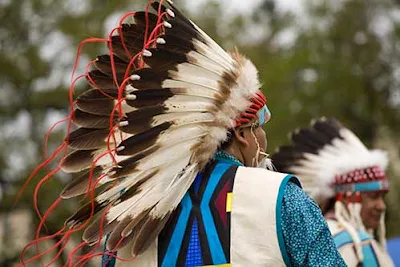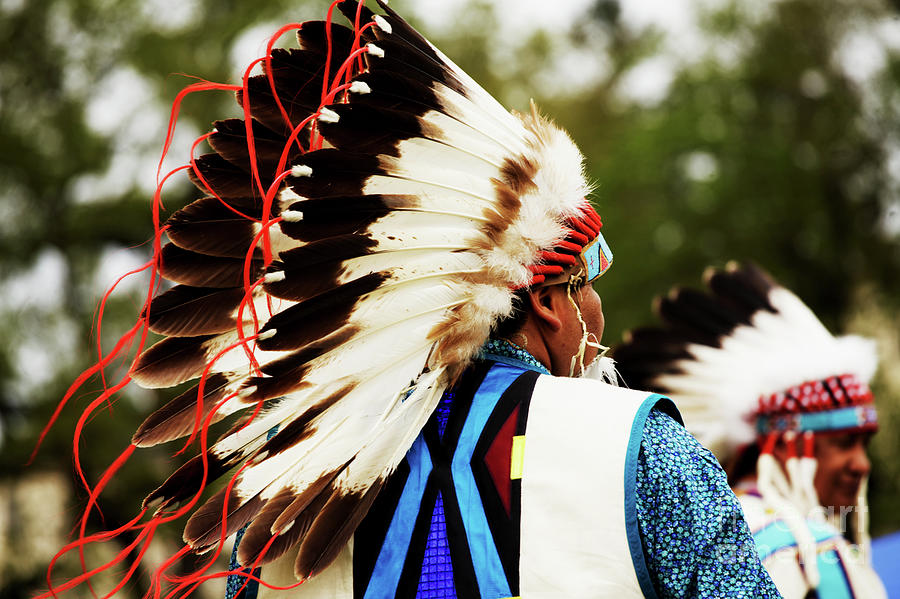1st Native American Day celebrated in 1916, honoring American Indians is celebrated today and every year on this date. This particular tribe are from the Nez Perce Nation. The following data are from Wikipedia.
The Nez Perce area at the time of Lewis and Clark was approximately 17,000,000 acres (69,000 km2). It covered parts of Washington, Oregon, Montana, and Idaho, in an area surrounding the Snake, Salmon and the Clearwater rivers. The tribal area extended from the Bitterroots in the east to the Blue Mountains in the west between latitudes 45°N and 47°N.
In 1800, there were more than 70 permanent villages ranging from 30 to 200 individuals, depending on the season and social grouping. About 300 total sites have been identified, including both camps and villages. In 1805 the Nez Perce were the largest tribe on the Columbia River Plateau, with a population of about 6,000. By the beginning of the 20th century, the Nez Perce had declined to about 1,800 because of epidemics, conflicts with non-Indians, and other factors.
The Nez Perce, as many western Native American tribes, were migratory and would travel in seasonal rounds, according to where the abundant food was to be found at a given time of year. This migration followed a predictable pattern from permanent winter villages through several temporary camps, nearly always returning to the same locations year after year. They were known to go as far east as the Great Plains of Montana to hunt buffalo, and as far west as the west coast. In their travels Celilo Falls was a respected and favored location to fish for salmon on the Columbia River. They relied heavily on q'emes or camas gathered in the region between the Salmon and Clearwater River drainages as a food source.
The Nez Perce believed in spirits called weyekins (Wie-a-kins) which would, they thought, offer "a link to the invisible world of spiritual power". The weyekin would protect one from harm and become a personal guardian spirit. To receive a weyekin, a young girl or boy age 12 to 15 would go to the mountains on a vision quest. The person on quest would carry no weapons, eat no food, and drink very little water. There, he or she would receive a vision of a spirit that would take the form of a mammal or bird. This vision could appear physically or in a dream or trance. The weyekin was to bestow the animal's powers on its bearer—for example; a deer might give its bearer swiftness. A person's weyekin was very personal. It was rarely shared with anyone and was contemplated in private. The weyekin stayed with the person until death.
The Nez Perce National Historical Park includes a research center which has the park's historical archives and library collection. It is available for on-site use in the study and interpretation of Nez Perce history and culture.
To be clear I am not being paid or remunerated in any way by the Nez Perce for this, though the photo is mine from an event I attended.
Subscribe by email
The Nez Perce area at the time of Lewis and Clark was approximately 17,000,000 acres (69,000 km2). It covered parts of Washington, Oregon, Montana, and Idaho, in an area surrounding the Snake, Salmon and the Clearwater rivers. The tribal area extended from the Bitterroots in the east to the Blue Mountains in the west between latitudes 45°N and 47°N.
In 1800, there were more than 70 permanent villages ranging from 30 to 200 individuals, depending on the season and social grouping. About 300 total sites have been identified, including both camps and villages. In 1805 the Nez Perce were the largest tribe on the Columbia River Plateau, with a population of about 6,000. By the beginning of the 20th century, the Nez Perce had declined to about 1,800 because of epidemics, conflicts with non-Indians, and other factors.
The Nez Perce, as many western Native American tribes, were migratory and would travel in seasonal rounds, according to where the abundant food was to be found at a given time of year. This migration followed a predictable pattern from permanent winter villages through several temporary camps, nearly always returning to the same locations year after year. They were known to go as far east as the Great Plains of Montana to hunt buffalo, and as far west as the west coast. In their travels Celilo Falls was a respected and favored location to fish for salmon on the Columbia River. They relied heavily on q'emes or camas gathered in the region between the Salmon and Clearwater River drainages as a food source.
The Nez Perce believed in spirits called weyekins (Wie-a-kins) which would, they thought, offer "a link to the invisible world of spiritual power". The weyekin would protect one from harm and become a personal guardian spirit. To receive a weyekin, a young girl or boy age 12 to 15 would go to the mountains on a vision quest. The person on quest would carry no weapons, eat no food, and drink very little water. There, he or she would receive a vision of a spirit that would take the form of a mammal or bird. This vision could appear physically or in a dream or trance. The weyekin was to bestow the animal's powers on its bearer—for example; a deer might give its bearer swiftness. A person's weyekin was very personal. It was rarely shared with anyone and was contemplated in private. The weyekin stayed with the person until death.
The Nez Perce National Historical Park includes a research center which has the park's historical archives and library collection. It is available for on-site use in the study and interpretation of Nez Perce history and culture.
To be clear I am not being paid or remunerated in any way by the Nez Perce for this, though the photo is mine from an event I attended.
Subscribe by email






No comments:
Post a Comment
Comments